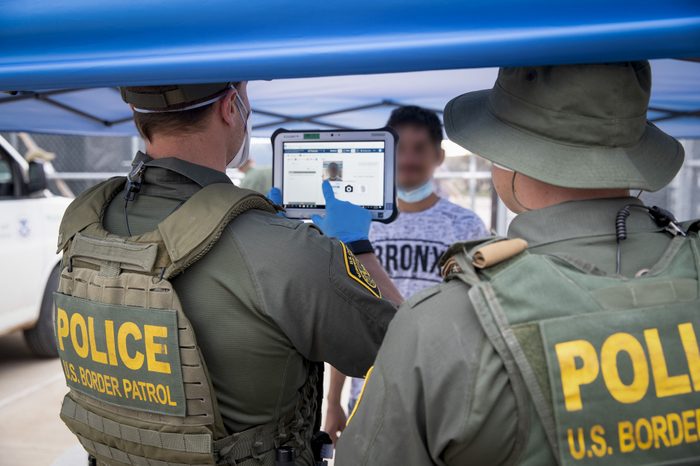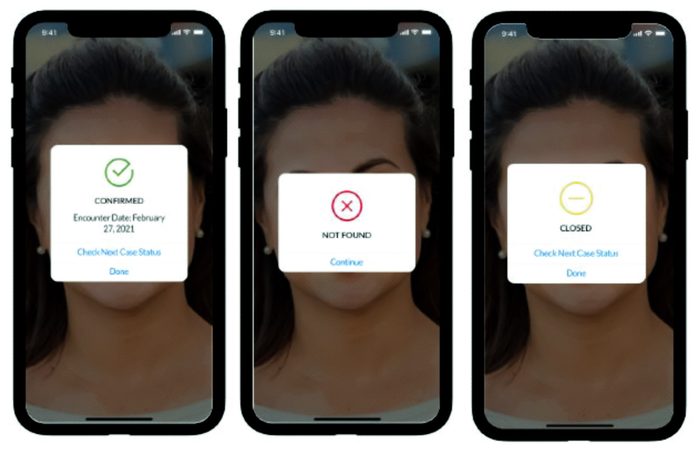The All-Seeing Eye of Homeland Security
From robot dogs to face recognition to e-shackles, Big Brother is watching migrants.
Adrian Rennix

The Department of Homeland Security (DHS) announced in February it was moving closer to patrolling the U.S.-Mexico border with “robot dogs.” The press release is written in the same irritating idiom one might find on the social media account of a presidential pet. DHS described the robots as “man’s best friend… with a very futuristic twist,” adding that the dogs would soon be lending “a helping hand (or ‘paw’)” to “U.S. Customs and Border Protection’s bipedal human personnel.”
The dogs are, of course, 100-pound, four-legged machines. They are produced by military contractor Ghost Robotics, which has previously demoed similar models armed with long-range guns (the DHS announcement indicates the dogs will only carry cameras and sensors so far). Presently, the dogs are being tested for rail car inspections and “sentry duty” on the border, patrolling under environmental conditions that would be difficult for Border Patrol agents. DHS’ description of the dogs’ capabilities — which include navigating “human-built environments like stairs” and “enter[ing] structures, mov[ing] through hallways, and peer[ing] around corners” during encounters with “potentially hostile individuals” seems to suggest they could be used in building raids. The notion of an already militarized border being patrolled by robots is disturbing, although it’s far from clear whether these robots are actually useful to CBP’s mission or are just an expensive toy — the dogs only have a four hour battery life and are remote-controlled by people.
On the whole, the cyber-pooch program fits into the government’s larger fantasy about a “smart wall” at the border, a proposal with frustrating (if predictable) levels of bipartisan support. Many of the same Democrats who decried former President Donald Trump’s expanded physical wall are now enthusiastically supporting a smart wall, involving motion- and light-sensitive fiber optic cables, aerial drones and facial recognition technology to intercept and deter migrants.
Smart wall proposals are far from new. George W. Bush’s presidency, for example, saw the launch of a project called the Secure Border Initiative Network, an integrated border surveillance network. The program shuttered under the Obama administration, after a scathing internal report suggested the unwieldy technology failed to justify its own expense.
Today, the quest for the smart wall continues and often involves shadowy contracts with private tech companies. In 2018, CBP contracted tech startup Anduril (named after Aragorn’s sword in Lord of the Rings) to build hundreds of swiveling, Eye-of-Sauron-style surveillance towers along the border. Broadly speaking, these efforts certainly sound sinister and are worth attention, but their tangible contributions to Border Patrol’s ability to detain migrants have, as far as we know, been quite limited. Historically, border surveillance towers without AI have sometimes reacted to animals and sent CBP agents scrambling to intercept wandering cows (although Anduril claims to have fixed this), while border guides have quickly learned how to distract and evade the sensors.
However, data published by border researchers Geoffrey Alan Boyce and Samuel Norton Chambers shows such towers appear to be connected to an increase in migrant deaths. Because of the towers’ foreboding appearance, migrants have taken to detours and alternate routes — usually into more dangerous, rugged terrain — to avoid them. In this respect, these high-tech deterrents are very similar to CBP’s more conventional enforcement efforts; deploying more visible barriers along the border, whether human or technological, frequently drives migrants to riskier routes.
This focus on the flashier, smart border wall can also distract from the less futuristic and more conventional ways DHS already uses technology to control migrants and invade their privacy, a phenomenon that penetrates deep into the interior of the United States. For example, CBP has purchased cell phone tracking data from private companies and used it to arrest migrants at the border. CBP also uses devices that can intercept cell phone data in real time, including text messages and voicemails.
And in October 2020, CBP quietly launched a new mobile app, called “CBP One,” ostensibly intended to facilitate more streamlined border crossings. Migrants in Mexico and the organizations assisting them are essentially required to use CBP One when seeking permission to approach the border to request asylum and to attend an asylum hearing. Asylum seekers send their biometric data over the app, and CBP uses this information and facial recognition technology to verify their identities.

CBP bypassed the otherwise legally required public comment period for launching this technology by winning “emergency approval” from the Office of Management and Budget. Initially, CBP concealed it would use CBP One with asylum seekers, instead focusing on its use for cargo inspections and other entry permits. Use of the app is technically voluntary for asylum seekers — they can, in theory, approach a port of entry or cross the border and surrender to Border Patrol to request asylum— but because all border ports of entry remain closed to asylum seekers, who are routinely turned back en masse (pursuant to the medically dubious Covid-19-related policy known as Title 42, instituted by the Trump administration and continued by the Biden), there is actually no realistic option, other than submitting biometric data through CBP One, to avoid summary turnback. And although migrants have little other choice, they have good reason to be concerned about the privacy implications of using CBP One.
The other most recent CBP program to use facial recognition technology at the border, in 2018, was hacked, compromising 180,000 photos. The information CBP collects also becomes part of a law enforcement database and remains accessible for up to 75 years. Downloading the CBP One app also gives CBP access to the user’s location, and although CBP has claimed it won’t use the app to track migrants — to find someone who missed a court date, for example, or to plan a raid — this promise is currently based on nothing more than scout’s honor. It also leaves sensitive biometric and geolocation data at the disposal of subsequent administrations.

The government also has big plans to expand the surveillance of asylum seekers within the United States and those who are fighting deportation in court. While the Biden administration has pledged to eliminate contracts with private prison companies, it has manifestly made no movement toward that goal with respect to immigration jails, almost all of which are operated by such companies. Biden has also allocated more resources to “alternatives to detention,” or ATD. The new federal budget, in addition to awarding millions to DHS to expand its biometrics database and explore other smart wall technologies, allocates $440 million to alternatives to detention. The phrase was initially used by immigration advocates to refer to community-based support programs offered to immigrant families throughout legal proceedings, which resulted in almost universal attendance at court hearings by participants — an important metric, because the government previously claimed detention was necessary to ensure participation in their legal proceedings.
Now, however, ATD refers to a suite of electronic monitoring and surveillance programs. These programs have previously required immigrants to report for in-person or telephone check-ins, to remain within certain geographic areas, to be subjected to unscheduled calls and home visits and to wear location-tracking ankle monitors. And the same companies that have been building and administering immigrant jails are heavily involved. DHS outsources its intensive supervision and ankle monitor programs, for example, to a company called BI Incorporated, a subsidiary of GEO Group, one of the biggest players in running immigrant detention centers. BI Incorporated also has its own proprietary mobile app for monitoring ATD enrollees, which uses facial recognition technology and location tracking in its surveillance.
This remote monitoring — or “e-carceration,” as some advocates call it — is effectively prison by another name. There’s even less oversight over e-carceration than traditional detention: Even the limited right to a bond hearing, which some detained immigrants have, doesn’t apply to electronic shackling and other supervision. In effect, once a migrant is placed under electronic supervision, it is difficult to challenge in immigration court. DHS also uses unclear and seemingly arbitrary standards to determine what intensity of surveillance immigrants should be subjected to — with the level of supervision having little clear relationship to any metric of “danger to the community.” Sometimes people who are physically frail or pregnant are subject to ankle shackling— and often, these decisions are left to the discretion of BI Incorporated, the for-profit prison company.
The U.S. immigration system also offers opportunities for even less reputable third parties to get in on the surveillance cash cow. A company called Libre by Nexus, for example, has infamously made millions in a rather novel way. First, it stands surety for detained immigrants who need assistance from bail bondsmen, so they can avoid being locked up. Then, Libre fits immigrants in their program with electronic shackles. Then, Libre charges the migrants outrageous monthly fees. Libre has been sued for deceptive business practices, and, in turn, Libre has sued its own subcontractors (from whom it leased monitoring equipment) for stealing private information from its customers, harassing them by phone and extorting them to remove their shackles.
E-carceration can also have devastating physical and psychological impacts. Immigrants required to wear physical ankle monitors have reported the devices cause swelling, numbness, cramps, chafing and blisters. In some horrifying incidents, monitors have actually burst into flame or delivered electric shocks to their wearers. Movement is limited by the heaviness of the device, by the fact that it only can hold a charge for a few hours and by the fact that it blares alarming messages if an immigrant leaves a particular radius.
Beyond these physical effects, the effects of surveillance are compounded by dangerous psychological impacts. Monitored immigrants may find it difficult to hold a job or may find themselves stigmatized and profiled as criminals in the community. In one survey, conducted by Cardozo Law School’s immigration clinic, 12% of immigrants subjected to electronic shackling said the experience made them feel suicidal, 71% reported it led to depression and 80% reported thinking about their shackle “constantly.” One survey participant noted, “Since I had the shackle I have become paranoid when I go outside, I feel like they are watching me.”
Another noted: “When I was in prison in my country, I was attacked and beaten. The ankle shackle reminds me of this, and makes me feel constantly stressed, afraid and despairing. It reminds me of my torture and I cannot stop thinking about it, as if I am still in prison.”
Although “alternatives to detention” implies such programs will reduce detention rates — and although proponents of e-carceration frequently cite its low cost relative to running a detention center — data shows there isn’t an inverse relationship between rates of traditional detention and the alternatives. In fact, both practices, profitably administered by the same companies, have generally increased overall, broadening the total pool of immigrants subjected to some form of restriction. Meanwhile, DHS confusingly claims that ATD is for people who don’t pose a flight risk, but that these people also should wear an intrusive and dehumanizing electronic surveillance device, since they might flee.
Most recently, the Biden administration has awarded GEO Group and BI Incorporated a new contract to pilot a home curfew program. This program would not only subject immigrants to electronic monitoring (with all of its attendant traumas and geographic limitations), but require immigrants to remain in their homes for 12 hours a day, from 8 p.m. to 8 a.m. The pilot, which a DHS spokesperson described to Reuters as “impactful detention reforms,” will be launched in Baltimore and Houston. In truth, home curfew is a euphemism for “house arrest” — and it amounts to imprisoning immigrants in their dwellings instead of in an offsite prison, in a kind of grotesque parody of the Covid-19-era work-from-home mindset.
Ultimately, it’s important to remember that the border is more than a line between the United States and Mexico; it exists everywhere in U.S. society, separating immigrants from nonimmigrants, authorized immigrants from unauthorized immigrants. This parallel police state extends across the country and is layered on top of the police state that most poor people and nonwhite people already experience. Physical walls and robot guards at the border are reprehensible, but this performative show of force is only the tip of a monstrous iceberg, a huge bipartisan campaign to monitor and physically control immigrants nationwide.
It’s easy for politicians to change their rhetorical inflection without changing their goals, to support a smart wall rather than a physical wall, or alternatives to detention instead of detention. The reality is that the government fully intends to pursue all of these options, all at once. They all exist in service of the same racist and xenophobic agenda. And they all must be resisted equally.
Adrian Rennix is an immigration attorney who works with detained asylum seekers in South Texas. The views expressed here are their own and not on behalf of any organization.







